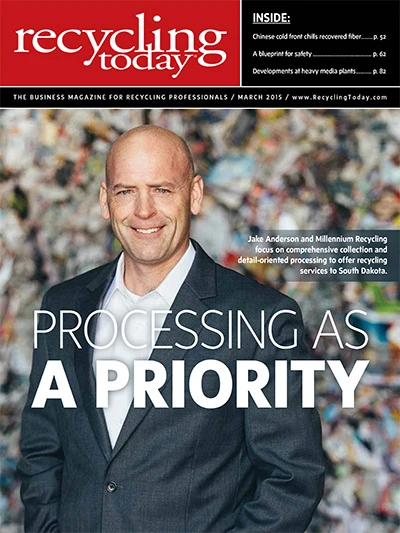It’s a difficult winter for nonferrous metals. Prices have been declining, demand is slow and generation is down. Some scrap dealers are describing nonferrous scrap markets as “bleak,” “lousy” and “horrendous.”
In the short term, copper, aluminum, stainless steel and other nonferrous scrap metals appear to be heading downward, with only a modest “dead cat” bounce for some grades possible this spring, sources predict.
According to a number of scrap dealers, these frigid markets could last well beyond winter because they can’t see a catalyst in the distance to spur an upswing in demand and price for nonferrous scrap.
The bleak outlook for nonferrous metals results from a combination of negative news at the market level as well as at the macroeconomic level. January also seemed to accelerate declines, putting many scrap dealers in a less-than-charitable mood.
One Midwestern scrap dealer describes the market as of early February as a “perfect storm” of bad news for the scrap industry. He lists a number of issues that are putting downward pressure on nonferrous markets, including the strong U.S. dollar, which is making offshore shipments more expensive; fairly soft economies in China and throughout much of Europe, which are reducing overall demand for nonferrous scrap; the backlog at West Coast ports in the United States, which is causing scrap to be redirected to domestic sources and ultimately flooding domestic consumers; and low oil prices, which are negatively affecting manufacturers that supply this industry.
The backlog at West Coast ports resulting from ongoing labor negotiations between the Pacific Maritime Association and the International Longshore and Warehouse Union is having a ripple effect throughout the scrap industry. (For more on the strike, see the article “Ports Pileup,” beginning on page 96 of this issue.) An aluminum scrap dealer based in the East says that as shipping material overseas becomes more difficult, scrap is being redirected to domestic consumers, flooding an already soft market. This ripple effect could linger for some time even if the parties sign a contract soon and work resumes as usual at West Coast ports.
Snowstorms throughout the Northeast also have had a negative effect on nonferrous scrap markets, curtailing generation of new scrap as well as activity at scrap yards.
“The lack of flow of material is really concerning,” one source based in the Northeast says.
He adds, “The overall U.S. economy may be pretty good, but the scrap economy is not.”
“It is a very competitive market for the available tons,” a scrap dealer based in the Midwest says. “Lots of people who overexpanded are in some serious problems right now.”
Exacerbating these challenges is the slowdown associated with China’s observance of the Lunar New Year, which was Feb. 19. Scrap consumers generally curtail their purchasing in anticipation of the holiday.
Copper scrap, which was trading in the $3-per-pound rage only a few months ago, is now moving in the $2.50-per-pound range, with little sign of strengthening in the near term. As of early February, Copper scrap prices have declined roughly 20 percent since December 2014, and some sources have said that prices touched a three-year low in January in response to a combination of soft demand and reduced generation.
The few scrap dealers who are conveying optimism in the short term say they feel that if prices fall much further, consumers might look to aggressively build their scrap inventories.
Few scrap dealers are forecasting an extended rally in pricing for copper scrap, however, with some saying that an uptick in pricing would be met with sufficient supply, tamping pricing back down.
Sponsored Content
Labor that Works
With 25 years of experience, Leadpoint delivers cost-effective workforce solutions tailored to your needs. We handle the recruiting, hiring, training, and onboarding to deliver stable, productive, and safety-focused teams. Our commitment to safety and quality ensures peace of mind with a reliable workforce that helps you achieve your goals.
Primary copper producers have responded to the current market conditions by cutting mining capacity. According to the investment house Macquarie, soft copper pricing has resulted in the temporary closure of seven mines, removing roughly 50,000 tons from the market.
The forecast for the aluminum scrap market may look promising in the long term; however, the outlook is less encouraging in the short term, according to a scrap dealer based on the East Coast. “I would describe the aluminum market right now as terrible,” he says.
Despite growing demand for aluminum from the automotive industry, the scrap dealer says he feels that aluminum producers will look to purchase prime scrap rather than the more traditional packages produced by scrap metal processors.
Secondary aluminum prices currently are seeing downward pressure as secondary smelters have fairly healthy inventories and are not aggressively purchasing scrap, sources say.
Another aluminum scrap broker based on the East Coast says domestic aluminum scrap consumers are finding adequate supply at fairly low prices currently.
Get curated news on YOUR industry.
Enter your email to receive our newsletters.

Explore the March 2015 Issue
Check out more from this issue and find your next story to read.
Latest from Recycling Today
- CP Group announces new senior vice president
- APR publishes Design Guide in French
- AmSty recorded first sales of PolyRenew Styrene in 2024
- PRE says EU’s plastic recycling industry at a breaking point
- Call2Recycle Canada, Staples Professional expand partnership
- Circular Services breaks ground on north Texas MRF
- Tariff uncertainty results in choppy nonferrous scrap flows
- CATL, Ellen MacArthur Foundation establish battery partnership








